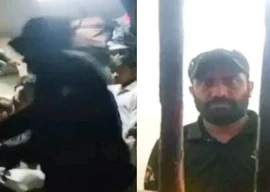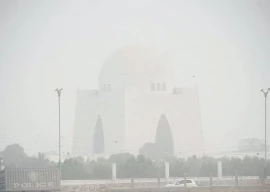
LAHORE:
A five-day art exhibition of Ayesha Zulfiqar’s work opened at the Drawing Room Gallery on Monday.
Art lovers are welcomed by a concrete and mud block placed in the middle of the walking lane. A twig hangs from a point inside the sewerage pipe that runs through the block. The block, around five-foot high and four-foot wide, has been titled Undercover and is on offer for $1,000. Two more pieces are on display.
In another display, the 26-year-old artist has sliced a root of a daali tree into six pieces and placed them irregularly. The root, Zulfiqar said, was acquired from the site of the Bus Rapid Transit System Project underway on Ferozepur Road in Lahore.
“No one sees the tree roots. I took this out of the ground, compressed it on a side for a more definitive shape and sliced it. The tree root slices have been presented it their natural form and are not very loaded,” she said while explaining the artifact.
Zulfiqar said her work could be interpreted at various levels and in various ways from “resisting one’s natural impulses” to “learning from nature about adapting to one’s surroundings”.
The third exhibit is a vertical block consisting of four mud-and-concrete pieces stacked above one another. It has a grass lining separating the layers.
“It’s not normal to grow grass in concrete,” Zulfiqar said, adding, that the piece pointed to the degree to which nature could be integrated into an artificial material.
The artist said that her work focused on exploring new mediums for sculpture. She told The Express Tribune that very few artists risked exploring new media, particularly natural.
Though she admitted that such experiments did not work every time, even failed attempts helped the artist improve.
“Although the exhibit showcases only three pieces, the message is beyond basic logic,” Nausheen Saeed, the artist’s former teacher at the National College of Arts and now a colleague, said. She appreciated Zulfiqar’s “brave attempt” and said she had worked in a conventional medium molded and represented in a very unconventional way.
“Showcasing such art at a gallery where visitors are more accustomed to regular paintings, is a refreshing surprise,” she added.
Sanam Taseer, owner of the Drawing Room Gallery, spoke fondly of the piece with the sewage pipe. “It is more subtle than the other two pieces, which I think are very raw,” she said.
Zulfiqar said the pieces were also reflective of the environmental degradation in Pakistan. She said she had worked on a concept that has yet to be explored by local artists.
The exhibition will continue till April 6.
Published in The Express Tribune, April 3rd, 2012.
COMMENTS (1)
Comments are moderated and generally will be posted if they are on-topic and not abusive.
For more information, please see our Comments FAQ

















































It's a pleasure knowing that art in Pakistan is still alive and kicking.
To me, this piece delivers a cautionary statement about the toll industrialization and urbanization is taking on nature. Exponential human growth has ostensibly engulfed nature itself, instead of coexisting with it.
It's disheartening, but brilliant.